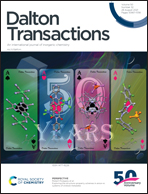Low temperature structures and magnetic interactions in the organic-based ferromagnetic and metamagnetic polymorphs of decamethylferrocenium 7,7,8,8-tetracyano-p-quinodimethanide, [FeCp*2]˙+[TCNQ]˙−†‡
Abstract
To identify the genesis of the differing magnetic behaviors for the ferro- (FO) and metamagnetic (MM) polymorphs of [FeCp*2][TCNQ] (Cp* = pentamethylcyclopentadienide; TCNQ = 7,7,8,8-tetracyano-p-quinodimethane) the low temperature (18 ± 1 K) structures of each polymorph were determined from high-resolution synchrotron powder diffraction data. Each polymorph possesses chains of alternating S = 1/2 [FeCp*2]˙+ cations and S = 1/2 [TCNQ]˙+, but with differing relative orientations. These as well as an additional paramagnetic polymorph do not thermally interconvert. In addition, the room and low (<70 ± 10 K) temperature structures of the MM polymorph, MMRT and MMLT, respectively, differ from that previously reported at 167 K (−106 °C) MM structure, and no evidence of either phase transition was previously noted even from the magnetic data. This transition temperature and enthalpy of this phase transition for MMRT ⇌ MM was determined to be 226.5 ± 0.4 K (−46.7 ± 0.4 °C) and 0.68 ± 0.04 kJ mol−1 upon warming, respectively, from differential calorimetry studies (DSC). All three MM phases are triclinic (P![[1 with combining macron]](https://www.rsc.org/images/entities/char_0031_0304.gif) ) with the room temperature phase having a doubled unit cell relative to the other two. The lower temperature phase transition involves a small rearrangement of the molecular ions and shift in lattice parameters. These three MM and FO polymorphs have been characterized and form extended 1-D chains with alternating S = 1/2 [FeCp*2]˙+ cations, and S = 1/2 [TCNQ]˙− anions, whereas the fifth, paramagnetic (P) polymorph possesses S = 0 π-[TCNQ]22− dimers. At 18 ± 1 K the intrachain Fe⋯Fe separations are 10.738(2) and 10.439(3) Å for the FO and MMLT polymorphs, respectively. The key structural differences between FO and MMLT at 18 ± 1 K are the 10% shorter interchain N⋯N and the 2.8% shorter intrachain Fe⋯Fe separation present for MMLT. Computational analysis of all nearest-neighbor spin couplings for the 18 K structures of FO and MMLT indicates that the intrachain [FeCp*2]˙+⋯[TCNQ]˙− spin couplings (H = −2Si·Sj) are the strongest (4.95 and 6.5 cm−1 for FO and MMLT, respectively), as previously hypothesized, and are ferromagnetic due to their S = 1/2 spins residing in orthogonal orbitals. The change in relative [TCNQ]˙−⋯[TCNQ]˙− orientations leads to a computed change from the ferromagnetic interaction (0.2 cm−1) for FO to an antiferromagnetic interaction (−0.1 cm−1) for MMLT in accord with its observed antiferromagnetic ground state. Hence, the magnetic ground state cannot be solely described by the dominant magnetic interactions.
) with the room temperature phase having a doubled unit cell relative to the other two. The lower temperature phase transition involves a small rearrangement of the molecular ions and shift in lattice parameters. These three MM and FO polymorphs have been characterized and form extended 1-D chains with alternating S = 1/2 [FeCp*2]˙+ cations, and S = 1/2 [TCNQ]˙− anions, whereas the fifth, paramagnetic (P) polymorph possesses S = 0 π-[TCNQ]22− dimers. At 18 ± 1 K the intrachain Fe⋯Fe separations are 10.738(2) and 10.439(3) Å for the FO and MMLT polymorphs, respectively. The key structural differences between FO and MMLT at 18 ± 1 K are the 10% shorter interchain N⋯N and the 2.8% shorter intrachain Fe⋯Fe separation present for MMLT. Computational analysis of all nearest-neighbor spin couplings for the 18 K structures of FO and MMLT indicates that the intrachain [FeCp*2]˙+⋯[TCNQ]˙− spin couplings (H = −2Si·Sj) are the strongest (4.95 and 6.5 cm−1 for FO and MMLT, respectively), as previously hypothesized, and are ferromagnetic due to their S = 1/2 spins residing in orthogonal orbitals. The change in relative [TCNQ]˙−⋯[TCNQ]˙− orientations leads to a computed change from the ferromagnetic interaction (0.2 cm−1) for FO to an antiferromagnetic interaction (−0.1 cm−1) for MMLT in accord with its observed antiferromagnetic ground state. Hence, the magnetic ground state cannot be solely described by the dominant magnetic interactions.
![Graphical abstract: Low temperature structures and magnetic interactions in the organic-based ferromagnetic and metamagnetic polymorphs of decamethylferrocenium 7,7,8,8-tetracyano-p-quinodimethanide, [FeCp*2]˙+[TCNQ]˙−](/en/Image/Get?imageInfo.ImageType=GA&imageInfo.ImageIdentifier.ManuscriptID=D1DT02106K&imageInfo.ImageIdentifier.Year=2021)


 Please wait while we load your content...
Please wait while we load your content...